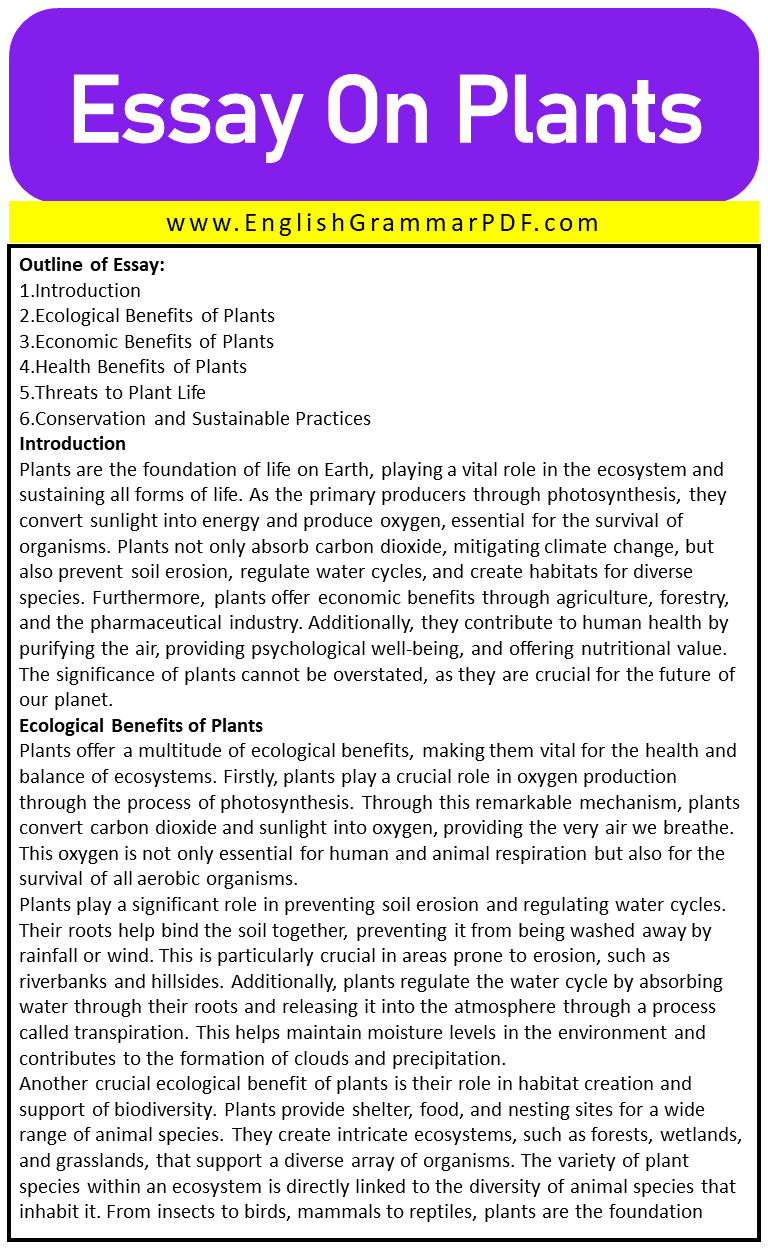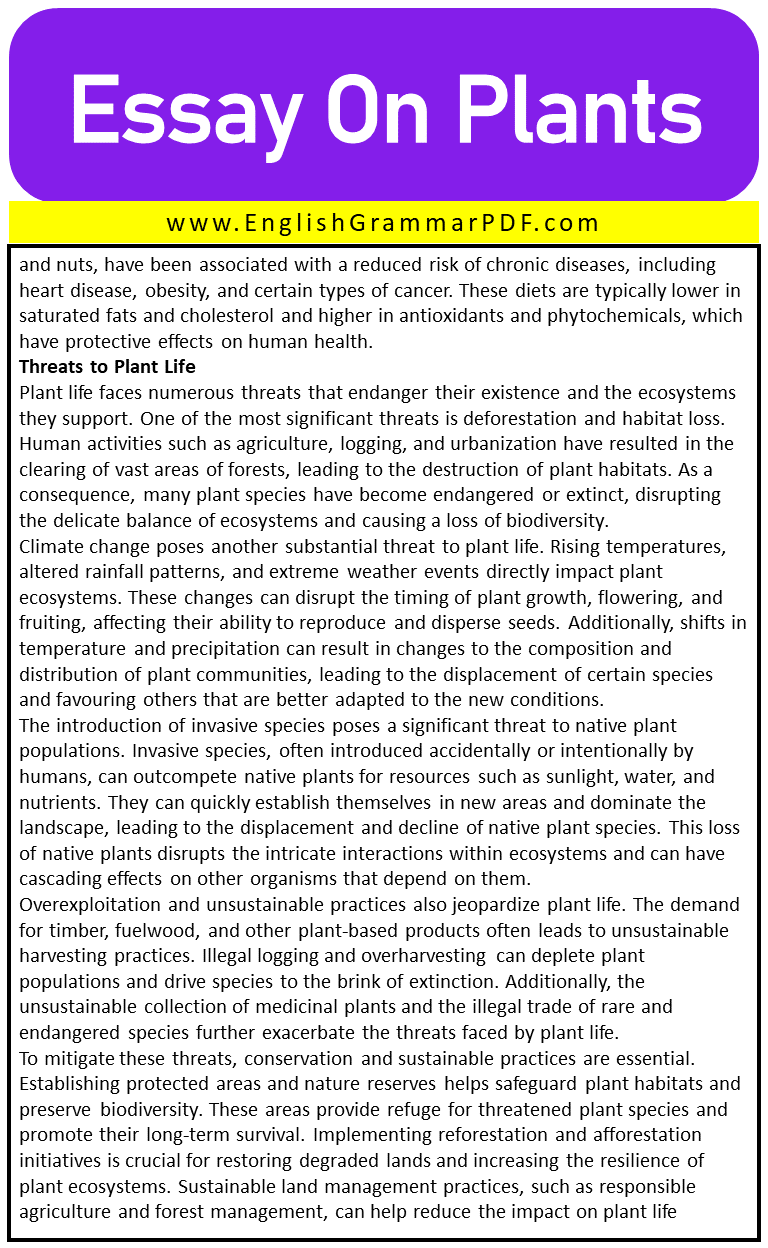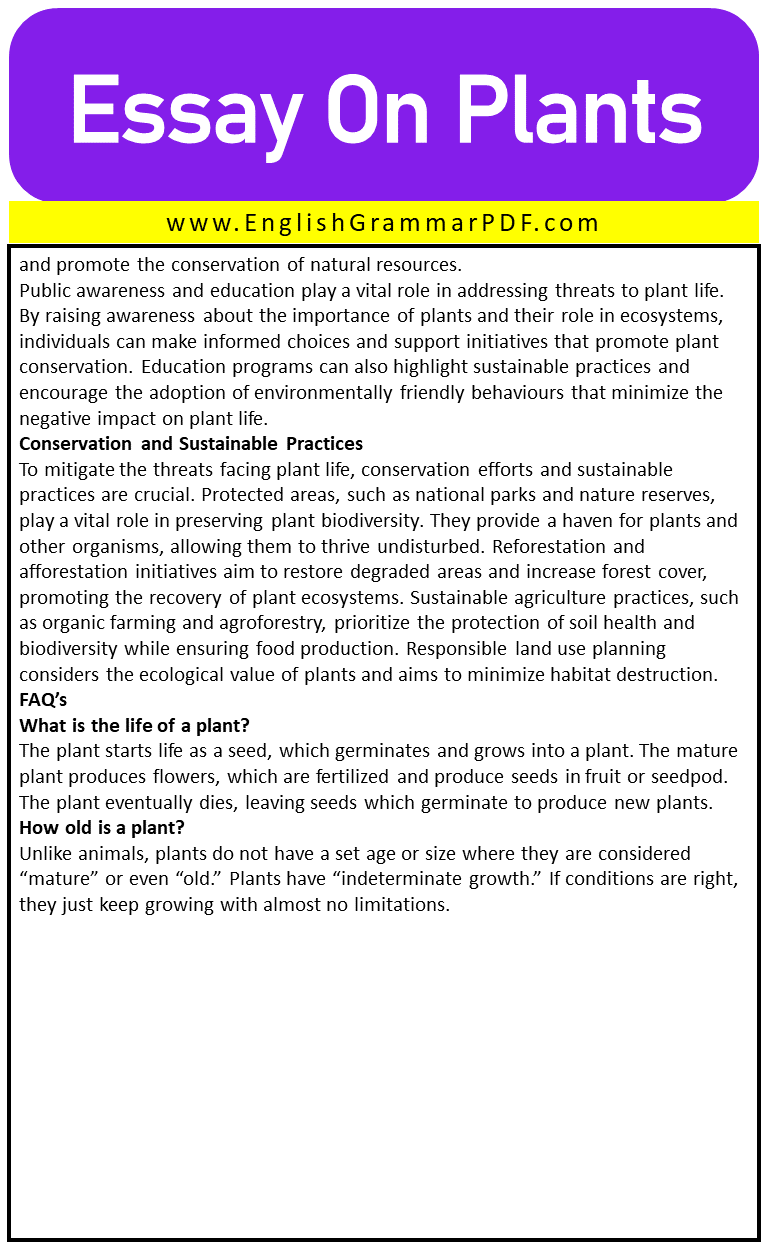Essay On Plants
Outline of Essay:
- Introduction
- Ecological Benefits of Plants
- Economic Benefits of Plants
- Health Benefits of Plants
- Threats to Plant Life
- Conservation and Sustainable Practices
Introduction
Plants are the foundation of life on Earth, playing a vital role in the ecosystem and sustaining all forms of life. As the primary producers through photosynthesis, they convert sunlight into energy and produce oxygen, essential for the survival of organisms. Plants not only absorb carbon dioxide, mitigating climate change, but also prevent soil erosion, regulate water cycles, and create habitats for diverse species. Furthermore, plants offer economic benefits through agriculture, forestry, and the pharmaceutical industry. Additionally, they contribute to human health by purifying the air, providing psychological well-being, and offering nutritional value. The significance of plants cannot be overstated, as they are crucial for the future of our planet.
Ecological Benefits of Plants
Plants offer a multitude of ecological benefits, making them vital for the health and balance of ecosystems. Firstly, plants play a crucial role in oxygen production through the process of photosynthesis. Through this remarkable mechanism, plants convert carbon dioxide and sunlight into oxygen, providing the very air we breathe. This oxygen is not only essential for human and animal respiration but also for the survival of all aerobic organisms.
Plants play a significant role in preventing soil erosion and regulating water cycles. Their roots help bind the soil together, preventing it from being washed away by rainfall or wind. This is particularly crucial in areas prone to erosion, such as riverbanks and hillsides. Additionally, plants regulate the water cycle by absorbing water through their roots and releasing it into the atmosphere through a process called transpiration. This helps maintain moisture levels in the environment and contributes to the formation of clouds and precipitation.
Another crucial ecological benefit of plants is their role in habitat creation and support of biodiversity. Plants provide shelter, food, and nesting sites for a wide range of animal species. They create intricate ecosystems, such as forests, wetlands, and grasslands, that support a diverse array of organisms. The variety of plant species within an ecosystem is directly linked to the diversity of animal species that inhabit it. From insects to birds, mammals to reptiles, plants are the foundation of these habitats and sustain the web of life. Moreover, plants contribute to the overall health and resilience of ecosystems. They filter pollutants and impurities from the air and water, improving the quality of these essential resources. Through their interactions with microorganisms in the soil, plants also play a critical role in nutrient cycling, ensuring the availability of essential elements for other organisms in the ecosystem.
Economic Benefits of Plants
Agriculture and food production heavily rely on plants. Crops such as grains, fruits, and vegetables serve as a primary source of sustenance for human populations. Additionally, plants have significant economic value through their use in various industries. For instance, the forestry sector relies on trees for timber production, which is used as a building material for construction, furniture, and paper products. The timber industry has a substantial economic impact, providing employment opportunities and contributing to economic growth. Moreover, plants with medicinal properties have been used for centuries in traditional medicine and continue to play a significant role in the pharmaceutical industry. The extraction of plant-derived drugs has enormous economic potential, offering solutions to various health conditions.
Health Benefits of Plants
Plants offer numerous health benefits to both the natural environment and human well-being. Firstly, plants contribute to air purification and the improvement of indoor air quality. Through the process of photosynthesis, plants absorb carbon dioxide and release oxygen, helping to remove harmful pollutants and toxins from the air. This purification process plays a crucial role in reducing air pollution and creating a healthier atmosphere for all living organisms.
Beyond air purification, plants have been found to have significant psychological and mental health benefits. Research has shown that exposure to nature and green spaces has a positive impact on mental well-being. The concept of biophilic design, which incorporates natural elements like plants into indoor spaces, has gained traction due to its ability to reduce stress, enhance cognitive function, and improve mood. Green spaces, such as parks, gardens, and forests, provide opportunities for relaxation, physical activity, and connection with nature, all of which contribute to improved mental health and well-being.
Plants also offer nutritional value and dietary benefits, contributing to human health. They are rich sources of essential nutrients such as vitamins, minerals, and dietary fibre. Incorporating a variety of plants into one’s diet promotes overall health and provides the body with the necessary nutrients for optimal functioning. Plant-based diets, which emphasize fruits, vegetables, whole grains, legumes, and nuts, have been associated with a reduced risk of chronic diseases, including heart disease, obesity, and certain types of cancer. These diets are typically lower in saturated fats and cholesterol and higher in antioxidants and phytochemicals, which have protective effects on human health.
Threats to Plant Life
Plant life faces numerous threats that endanger their existence and the ecosystems they support. One of the most significant threats is deforestation and habitat loss. Human activities such as agriculture, logging, and urbanization have resulted in the clearing of vast areas of forests, leading to the destruction of plant habitats. As a consequence, many plant species have become endangered or extinct, disrupting the delicate balance of ecosystems and causing a loss of biodiversity.
Climate change poses another substantial threat to plant life. Rising temperatures, altered rainfall patterns, and extreme weather events directly impact plant ecosystems. These changes can disrupt the timing of plant growth, flowering, and fruiting, affecting their ability to reproduce and disperse seeds. Additionally, shifts in temperature and precipitation can result in changes to the composition and distribution of plant communities, leading to the displacement of certain species and favouring others that are better adapted to the new conditions.
The introduction of invasive species poses a significant threat to native plant populations. Invasive species, often introduced accidentally or intentionally by humans, can outcompete native plants for resources such as sunlight, water, and nutrients. They can quickly establish themselves in new areas and dominate the landscape, leading to the displacement and decline of native plant species. This loss of native plants disrupts the intricate interactions within ecosystems and can have cascading effects on other organisms that depend on them.
Overexploitation and unsustainable practices also jeopardize plant life. The demand for timber, fuelwood, and other plant-based products often leads to unsustainable harvesting practices. Illegal logging and overharvesting can deplete plant populations and drive species to the brink of extinction. Additionally, the unsustainable collection of medicinal plants and the illegal trade of rare and endangered species further exacerbate the threats faced by plant life.
To mitigate these threats, conservation and sustainable practices are essential. Establishing protected areas and nature reserves helps safeguard plant habitats and preserve biodiversity. These areas provide refuge for threatened plant species and promote their long-term survival. Implementing reforestation and afforestation initiatives is crucial for restoring degraded lands and increasing the resilience of plant ecosystems. Sustainable land management practices, such as responsible agriculture and forest management, can help reduce the impact on plant life and promote the conservation of natural resources.
Public awareness and education play a vital role in addressing threats to plant life. By raising awareness about the importance of plants and their role in ecosystems, individuals can make informed choices and support initiatives that promote plant conservation. Education programs can also highlight sustainable practices and encourage the adoption of environmentally friendly behaviours that minimize the negative impact on plant life.
Conservation and Sustainable Practices
To mitigate the threats facing plant life, conservation efforts and sustainable practices are crucial. Protected areas, such as national parks and nature reserves, play a vital role in preserving plant biodiversity. They provide a haven for plants and other organisms, allowing them to thrive undisturbed. Reforestation and afforestation initiatives aim to restore degraded areas and increase forest cover, promoting the recovery of plant ecosystems. Sustainable agriculture practices, such as organic farming and agroforestry, prioritize the protection of soil health and biodiversity while ensuring food production. Responsible land use planning considers the ecological value of plants and aims to minimize habitat destruction.
FAQ’s
What is the life of a plant?
The plant starts life as a seed, which germinates and grows into a plant. The mature plant produces flowers, which are fertilized and produce seeds in fruit or seedpod. The plant eventually dies, leaving seeds which germinate to produce new plants.
How old is a plant?
Unlike animals, plants do not have a set age or size where they are considered “mature” or even “old.” Plants have “indeterminate growth.” If conditions are right, they just keep growing with almost no limitations.
Explore More Essays:
Download the PDF of the Essay:







